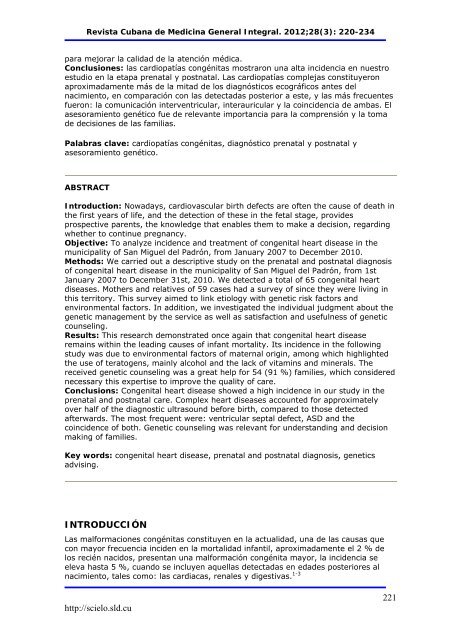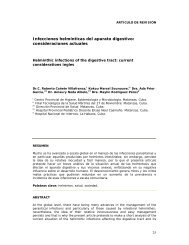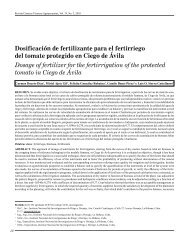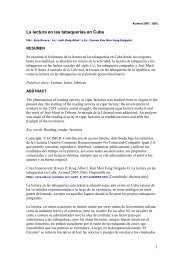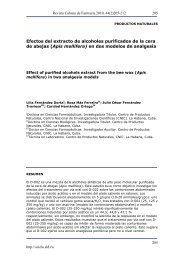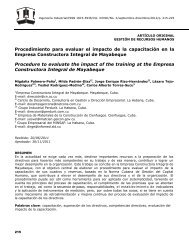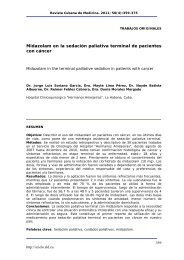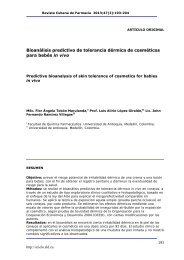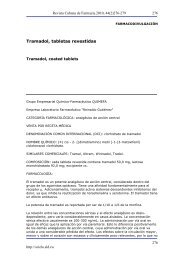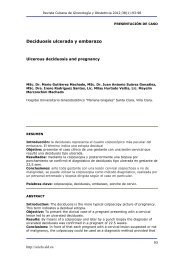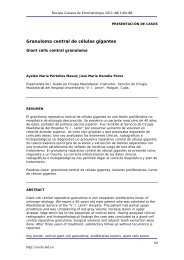Revista Cubana <strong>de</strong> Medicina General Integral. 2012;28(3): 220-234para mejorar la calidad <strong>de</strong> la atención médica.Conclusiones: <strong>las</strong> <strong>cardiopatías</strong> congénitas mostraron una alta inci<strong>de</strong>ncia en nuestroestudio en la etapa prenatal y postnatal. Las <strong>cardiopatías</strong> complejas constituyeronaproximadamente más <strong>de</strong> la mitad <strong>de</strong> los diagnósticos ecográficos antes <strong>de</strong>lnacimiento, en comparación con <strong>las</strong> <strong>de</strong>tectadas posterior a este, y <strong>las</strong> más frecuentesfueron: la comunicación interventricular, interauricular y la coinci<strong>de</strong>ncia <strong>de</strong> ambas. E<strong>las</strong>esoramiento genético fue <strong>de</strong> relevante importancia para la comprensión y la toma<strong>de</strong> <strong>de</strong>cisiones <strong>de</strong> <strong>las</strong> familias.Palabras clave: <strong>cardiopatías</strong> congénitas, diagnóstico prenatal y postnatal yasesoramiento genético.ABSTRACTIntroduction: Nowadays, cardiovascular birth <strong>de</strong>fects are often the cause of <strong>de</strong>ath inthe first years of life, and the <strong>de</strong>tection of these in the fetal stage, provi<strong>de</strong>sprospective parents, the knowledge that enables them to make a <strong>de</strong>cision, regardingwhether to continue pregnancy.Objective: To analyze inci<strong>de</strong>nce and treatment of congenital heart disease in themunicipality of San Miguel <strong>de</strong>l Padrón, from January 2007 to December 2010.Methods: We carried out a <strong>de</strong>scriptive study on the prenatal and postnatal diagnosisof congenital heart disease in the municipality of San Miguel <strong>de</strong>l Padrón, from 1stJanuary 2007 to December 31st, 2010. We <strong>de</strong>tected a total of 65 congenital heartdiseases. Mothers and relatives of 59 cases had a survey of since they were living inthis territory. This survey aimed to link etiology with genetic risk factors an<strong>de</strong>nvironmental factors. In addition, we investigated the individual judgment about thegenetic management by the service as well as satisfaction and usefulness of geneticcounseling.Results: This research <strong>de</strong>monstrated once again that congenital heart diseaseremains within the leading causes of infant mortality. Its inci<strong>de</strong>nce in the followingstudy was due to environmental factors of maternal origin, among which highlightedthe use of teratogens, mainly alcohol and the lack of vitamins and minerals. Thereceived genetic counseling was a great help for 54 (91 %) families, which consi<strong>de</strong>rednecessary this expertise to improve the quality of care.Conclusions: Congenital heart disease showed a high inci<strong>de</strong>nce in our study in theprenatal and postnatal care. Complex heart diseases accounted for approximatelyover half of the diagnostic ultrasound before birth, compared to those <strong>de</strong>tectedafterwards. The most frequent were: ventricular septal <strong>de</strong>fect, ASD and thecoinci<strong>de</strong>nce of both. Genetic counseling was relevant for un<strong>de</strong>rstanding and <strong>de</strong>cisionmaking of families.Key words: congenital heart disease, prenatal and postnatal diagnosis, geneticsadvising.INTRODUCCIÓNLas malformaciones congénitas constituyen en la actualidad, una <strong>de</strong> <strong>las</strong> causas quecon mayor frecuencia inci<strong>de</strong>n en la mortalidad infantil, aproximadamente el 2 % <strong>de</strong>los recién nacidos, presentan una malformación congénita mayor, la inci<strong>de</strong>ncia seeleva hasta 5 %, cuando se incluyen aquel<strong>las</strong> <strong>de</strong>tectadas en eda<strong>de</strong>s posteriores alnacimiento, tales como: <strong>las</strong> cardiacas, renales y digestivas. 1-3http://scielo.sld.cu221
Revista Cubana <strong>de</strong> Medicina General Integral. 2012;28(3): 220-234La mayoría <strong>de</strong> <strong>las</strong> lesiones cardiacas congénitas, son más tolerables durante la vidafetal, solo cuando se elimina la circulación materna y el sistema cardiovascular <strong>de</strong>lrecién nacido se hace in<strong>de</strong>pendiente, se pone <strong>de</strong> manifiesto el impacto <strong>de</strong> untrastorno anatómico y <strong>de</strong>spués hemodinámico.El proceso <strong>de</strong> formación <strong>de</strong> <strong>las</strong> estructuras cardiacas <strong>de</strong>finitivas es complejo. Se iniciaalre<strong>de</strong>dor <strong>de</strong> la tercera semana <strong>de</strong> vida intrauterina y finaliza posteriormente alnacimiento. El periodo vulnerable para el <strong>de</strong>sarrollo <strong>de</strong> una malformación <strong>de</strong>l corazónfetal, comienza a los 14 días <strong>de</strong> la concepción, y se pue<strong>de</strong> exten<strong>de</strong>r hasta los 60 días.En el 85 % <strong>de</strong> <strong>las</strong> malformaciones congénitas cardiacas, se involucran factoresgenético-ambientales, es <strong>de</strong>cir, multifactoriales, y en el 15 % restante existe unaherencia monogénica (afección <strong>de</strong> un gen específico) o una anomalía cromosómica,generalmente acompañando a un síndrome genético. 4,5Las <strong>cardiopatías</strong> congénitas pue<strong>de</strong>n ser aisladas o asociadas con otras malformacionesextracardiacas. Los <strong>de</strong>fectos congénitos cardiacos, se pue<strong>de</strong>n c<strong>las</strong>ificar en <strong>de</strong>fectos <strong>de</strong>posición o <strong>de</strong>fectos estructurales.Las <strong>cardiopatías</strong> más frecuentes son la comunicación interventricular (CIV) con un18-20 % <strong>de</strong>l total, la comunicación interauricular (CIA) 5-8 % y el ductus arteriosopersistente (PCA) en 5-10 %. También se encuentran <strong>las</strong> <strong>cardiopatías</strong> congénitascianóticas, y la más frecuente es la tetralogía <strong>de</strong> Fallot (TF), que es responsable <strong>de</strong>entre 5 y 10 % <strong>de</strong> todos los <strong>de</strong>fectos cardiacos.Algunas <strong>cardiopatías</strong> se manifestan poco <strong>de</strong>spués <strong>de</strong> nacer, relacionadas a menudocon el paso <strong>de</strong> la circulación fetal a la postnatal (con oxigenación <strong>de</strong>pendiente <strong>de</strong> lospulmones, y no <strong>de</strong> la placenta). Otras, sin embargo, no se manifiestan hasta la edadadulta. 6,7,8El diagnóstico precoz <strong>de</strong> estas patologías <strong>de</strong>l corazón es importante, ya que lapresentación clínica pue<strong>de</strong> ser brusca, y pue<strong>de</strong> producir incluso la muerte. Sonreconocidas <strong>las</strong> dificulta<strong>de</strong>s para el diagnóstico <strong>de</strong> estas, durante el examen neonatal.Defectos mayores pue<strong>de</strong>n pasar inadvertidos y manifestarse clínicamente <strong>de</strong> formatardía. El método más efectivo para su diagnóstico es la ecocardiografía. El pronósticoperinatal <strong>de</strong> <strong>las</strong> formas críticas mejora, si su diagnóstico es efectuado durante elperiodo antenatal.Las malformaciones cardiacas son comunes (8/1 000 embarazadas), y por lo tanto, laevaluación <strong>de</strong>l corazón fetal es <strong>de</strong> obligada relevancia, en el ultrasonido obstétrico <strong>de</strong>rutina <strong>de</strong> toda mujer embarazada. Se ha <strong>de</strong>mostrado que con un análisis a<strong>de</strong>cuado <strong>de</strong><strong>las</strong> cuatro cámaras cardiacas, se <strong>de</strong>tecta el 60 % <strong>de</strong> <strong>las</strong> malformaciones serias, y si seincluye a<strong>de</strong>más la visualización <strong>de</strong> ambos tractos <strong>de</strong> salida, el porcentaje <strong>de</strong> <strong>de</strong>tecciónaumenta hasta un 90 %. 8Los padres que han tenido un hijo con serias anomalías, <strong>de</strong>ben reflexionar acerca <strong>de</strong>los factores que han podido ocasionar tal condición, en especial si los hijos que tenganen el futuro, pue<strong>de</strong>n verse igualmente afectados.El Policlínico Universitario "California" cuenta con el Servicio <strong>de</strong> Genética Municipal,don<strong>de</strong> se le ofrece atención a la gestante teniendo en cuenta su riesgo genético yobstétrico, a<strong>de</strong>más se realiza la valoración y estudio <strong>de</strong>l recién nacido. Losecografistas realizan el diagnóstico <strong>de</strong> <strong>de</strong>fectos congénitos incluyendo <strong>las</strong>malformaciones cardiacas, y se asesora posteriormente a la futura mamá, a la parejay familiares, <strong>de</strong> acuerdo con el pronóstico fetal y la calidad <strong>de</strong> vida neonatal.http://scielo.sld.cu222


